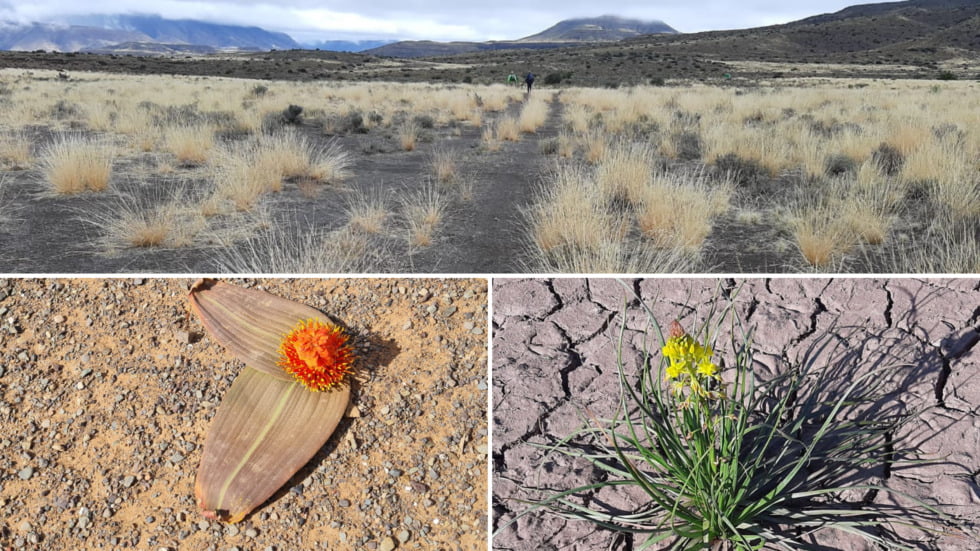
The Karoo Basin was formed over millions of years; deep in ancient times and under different climates when thousands of metres of sediments were deposited, and which now represent the Karoo rocks. This very age of the area gives the Karoo its mystery and fascination – gently coloured in desert shades, superb sunsets and an almost incomprehensible length of history. It is an inspiration to poets, writers and artists – and those who enjoy open spaces, solitude and breath-taking starlit heavens.
The Karoo is famous for a variety of factors – but possibly the most important is the fact that despite the harsh environment, it supports many different and unique plants. Situated across the south western area of South Africa, the Karoo is recognised as a hot-spot of global significance with regard to flora diversity, and is home to the richest array of succulent plant species on Earth.
These are hardy plants that have developed over many centuries and eons of climate change. They have become species-rich as a result of adaption to extreme climatic conditions over long periods of time. The present distribution of the Karoo’s vegetation owes origin to massive geological and climatic events of the relatively recent past.
The Karoo “bossies” (several plant species consisting of grassy shrublands, grassy dwarf shrublands, and succulent dwarf shrublands) give the Karoo its original character and flavour, and provide a basic browsing source for many of the wildlife species. While bouts of drought are a natural occurrence in the Karoo, not all are severe. Karoo plants have developed stout resistance and rarely succumb to a lack of water.
The Succulent Karoo
- The Succulent Karoo covers approximately 83,000 km, and includes Namaqualand and the Richtersveld.
- The region is extremely dry in summer and the temperature often rises above 40C. Rain falls in winter and can vary from 20 to 290mm per year.
- The Succulent Karoo boasts the largest number of succulentplants in the world for a region of its size. Most of these plants have thick succulent leaves, and many are very tiny, like the stone plants.
- Plants in the Succulent Karoo are well adapted to survive extremely dry summers. Plants like small vygies and crassulas and the large Quiver tree, store water in their leaves and/or stems. The well-loved and popular annual daisies are dormant in summer but grow and flower after winter rains. The area is famous for the vivid burst of blooms and remarkable variety of flowers in spring.
The Nama Karoo
- The Nama Karoo is the third largest biome in South Africa, covering about 20% of the country, or more than 260 000 km. It stretches across the vast central plateau of the western half of the country.
- It is a semi-desert that receives a little rain in summer. Rainfall varies from about 200 mm per year in the west to 400 mm per year in the north-east. Summer is extremely hot and winter cold with frequent frost.
- Most of the plants are low shrubs and grasses, with many being Trees like the Sweet Thorn (Acacia Karoo) are usually only found along rivers or on rocky hillsides.
- In the past, vast herds of Springbok used to migrate through the region in search of water and grazing, but the area is now more focused on sheep and goat farming, along with the production of olives, citrus and deciduous fruit.
The Little Karoo
- Forming part of the Karoo Succulent Biome, the Little Karoo region is a semi-arid basin located between the Langeberg, Outeniqua and Tsitsikamma mountains to the south, and the Swartberg mountains to the north. More than 3200 plant species occur across the region, of which more than 400 species are endemic to the area and are not found anywhere else on earth.
- Despite relatively low average annual rainfall as a result of the rain shadow caused by surrounding mountain ranges, the Little Karoo is one of South Africa’s prime agricultural areas with extensive vineyards, stone fruits farming, as well as livestock farming including sheep, cattle and ostrich farms.
- However, over the last three centuries, the diverse flora of the Karoo has reportedly undergone wide scale and dramatic change, causing concern among farmers and conservationists alike. The advent of pastoralism and the small stock industry has been widely cited as the main cause of the more recent vegetation changes in the Karoo.
- The Little Karoo’s biodiversity remains particularly special due to the variety of different vegetation types that intersect across the region, ranging from uplands to lowlands, influenced by environmental factors that include local geology, average annual rainfall, temperature and fire cycles.
- In the mountains that surround the region, fynbos vegetation can be found in the higher altitudes that receive higher rainfall. As a result of a complex hydrology that feeds into the area, the fynbos mountains act as ‘living sponges’ in areas where the rainfall is higher, feeding fresh water into streams that in turn, feed into larger watercourses and groundwater, providing irrigation for farms.
Heuningland: African & Karoo tours to stir the heart and lift the soul
We are proudly South African and have a fervent love of the Great Karoo, its people and its unique vegetation and animals. We are passionate conservationists of nature and would like to share our knowledge acquired through years of travel and touring experience. We are therefore able to offer custom-designed and distinctively different tour options:
- Hiking/camping trails or guided self-driving tours through the ancient landscape of the Karoo.
- Tailor-made safaris to any destination in South Africa, Namibia, Zimbabwe, Zambia, Mozambique, and Botswana.
Find out more at: www.heuningland.com




